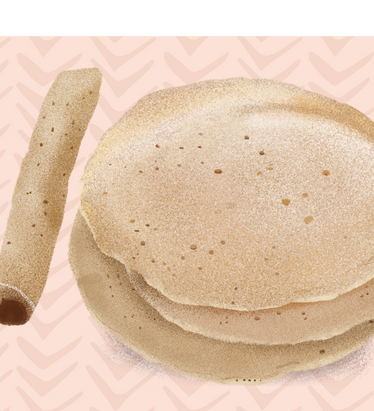
Resources
Our Flavorful World: Pancakes
The pancake has a delicious form in nearly every food culture. Explore pancakes from around the world with your family.
I love pancakes in all forms. Flatbreads that are spongy or flakey, fluffy breakfast stacks, fried, griddled, toasted, baked, stuffed, topped, savory or sweet … let me at 'em. Knowing how many types of flatbreads and pancakes there are in the world, I find it nearly impossible to believe that there isn’t at least one out there, if not a multitude, for everyone to love. I grew up eating appams, a South Indian speciality, for Christmas and Easter mornings. To this day I crave those lacy edges and spongy centers on every holiday. Here are a few of my other favorites from around the world—tell me, what are yours?
Appam / Dosa
It is absolutely impossible for me to list every delicious pancake made on the Indian subcontinent (Pitha! Meetha Pooda! Malpua! Paratha! Poori!) so I’m just telling you about two of my favorites. Watching someone make either appams or dosa is a truly mesmerizing experience. Appams and Dosas are both made with a fermented rice batter, which has a really distinct and tantalizing smell and flavor. Appam includes coconut milk, while dosa typically includes urad dal. My favorite kind of appam (oh yeah, there are a myriad of different appams too!) is a palappam, a speciality of Kerala. It has a spongy, soft center with crispy lacy edges, and is perfect for soaking up chicken ishtu or mutton curry, which is what my mom used to make with it. My favorite dosa (yep, there are many kinds of dosa too!) is masala dosa, a huge, crispy griddled pancake rolled and stuffed with a spicy potato masala, served with sambar and—my favorite—fresh coconut chutney.
Okonomiyaki
Okonomiyaki as a word broken down means “what you like” and “cooked”. It is literally telling you in its name, ‘I am exactly what you want me to be.’ I have never been to Japan to have one at the source, but it is definitely a bucket list food pilgrimage for me. The batter is made from a root vegetable called nagaimo, and results in a satisfyingly squishy, soft base for your preferred mix-ins. Okonomiyaki differs regionally in preparation—sometimes the fixings are mixed into the batter, sometimes they are layered on top—but are in any case a beautiful and exciting combination of textures and flavors.
Injera
I remember trying Injera for the first time with my uncle in a small Ethiopian restaurant in DC. He took me there because he knew how much I loved appam, and thought that maybe I’d enjoy trying a similar-but-different version. He was totally right. I loved the entire experience, particularly the communal aspect of the injera being the base upon which the meal was served, as well as the utensil. Injera is traditionally made from an ancient grain called teff, (though occasionally other grains are used as well), and is the national dish of both Ethiopia and Eritrea. I can distinctly remember the texture, and how it changed whether it was plain and used to scoop something up, or had been soaked in one of the delicious wat on top of it, as well as the distinctive tang that seemed to electrify every bite. That tang comes from the fermentation process, which is also what gives injera its pockets of air and springy texture, and makes it so good for soaking up the variety of flavors on top of it.
Arepa
There was an excellent Venezuelan restaurant just a few blocks away from my old apartment in Astoria with amazing lightly crisp-on-the-outside, tender/airy/fluffy/rich-on-the-inside arepas, and I’d take just about any excuse to walk over there and pick one (or several) up for a meal or a snack. Arepas are found in a huge variety of forms across South America, and particularly in Venezuela and Colombia. This dough is made from corn, dried and pounded into flour. They can be grilled, griddled, baked, or fried, and can be topped or stuffed with just about anything. For me, there was something so texturally appealing and tasty about the arepa itself that I could have eaten it plain, but my favorite order was the pabellon arepa, stuffed with shredded beef, sweet plantains, black beans, and cotija cheese. Brb, moving back to Astoria now…
Craving more?
- Crepes from France!
- Bing from China!
- Latkes from Eastern Europe!
- Jeon from Korea!
- Dutch Baby from USA!

